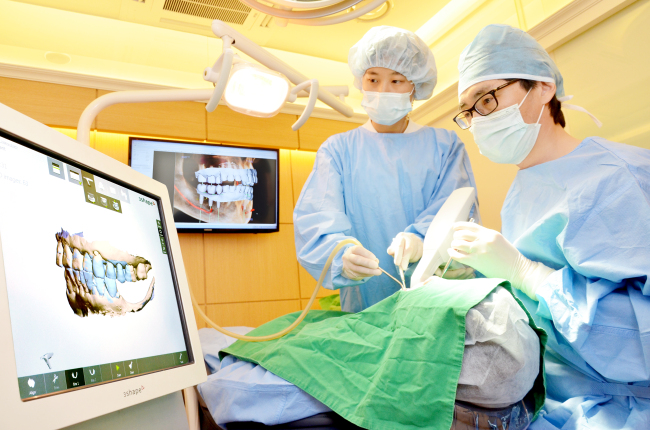3-D tech reduces pain, boosts accuracy in dental surgery
New equipment has reduced the burden of patients while raising their satisfaction.
By Lee Hyun-jeongPublished : Jan. 16, 2014 - 20:30
The use of 3-D technology has expanded to medicine, especially in dentistry, helping to maximize accuracy in surgery while reducing pain.
In the past, the most developed method of putting in dental implants was cutting into the gums after looking at problematic spots on X-rays. Not only did the surgery take a long time, but the pain and bleeding were excruciating.
But new equipment have reduced patient discomfort and increased satisfaction.
In the past, the most developed method of putting in dental implants was cutting into the gums after looking at problematic spots on X-rays. Not only did the surgery take a long time, but the pain and bleeding were excruciating.
But new equipment have reduced patient discomfort and increased satisfaction.

Dental 3-D computed tomography, one of the most up-to-date imaging techniques, enables doctors to map the entire structure of a patient’s mouth, including the gums, bones and nerves. The new equipment helps them find the minimum amount of bone that has to be removed to put in an implant and the ideal location for it. It also allows dentists to conduct computer simulations to check in advance the amount of bone that will be left after surgery and to avoid unnecessary operations.
Oral scanners also help health care providers check the gum line more accurately by scanning the inside of mouth quickly without making a plaster cast.
3-D technology is also used to make abutments, which connect the crown to the screw of the dental implant. The possibility of periodontitis ― inflammation around the tooth ― is sharply reduced if the abutment is customized based on the individual’s oral condition.
“Once implanted, it’s generally used for about 10 to 20 years. Using accurate implants based on one’s gum condition is very important,” said Lee Jeong-tack, an orthodontist at S-Plant Dental Hospital in Seoul’s Cheongdam-dong.
“Implant methods using 3-D technology will continuously be developed to raise surgical precision,” he added.
To make the most of the latest 3-D technology, the hospital developed a dental implant procedure in a joint project with Anatomage, a U.S. company specializing in 3-D medical technology.
The procedure named the Anatomage Guide Dental Implant procedure helps doctors decide how to accurately position dental implants through 3-D CT scans. The method requires doctors to only drill a few small holes into the gum with a laser to place the implant accurately. By doing so, it reduces pain while quickening the recovery time, according to the hospital.
The Anatomage procedure also reduces surgery time, taking only two hours to put in 10 implants. Moreover, if the bone is in good condition, a temporary crown can be put in on the day of the surgery. Patients can even eat porridge later in the day.
“The 3-D medical technology itself doesn’t necessarily guarantee the success of the surgery. It’s only possible when it is performed by professionals who understand the equipment well,” said Roh Hyun-ki, a doctor at S-Plant Dental Hospital.
“If a patient considers having implant surgery, it’s important to consult an experienced expert,” he advised.
By Lee Hyun-jeong
(rene@heraldcorp.com)







![[Graphic News] More Koreans say they plan long-distance trips this year](http://res.heraldm.com/phpwas/restmb_idxmake.php?idx=644&simg=/content/image/2024/04/17/20240417050828_0.gif&u=)
![[KH Explains] Hyundai's full hybrid edge to pay off amid slow transition to pure EVs](http://res.heraldm.com/phpwas/restmb_idxmake.php?idx=644&simg=/content/image/2024/04/18/20240418050645_0.jpg&u=20240419100350)





![[From the Scene] Monks, Buddhists hail return of remains of Buddhas](http://res.heraldm.com/phpwas/restmb_idxmake.php?idx=652&simg=/content/image/2024/04/19/20240419050617_0.jpg&u=20240419175937)

![[KH Explains] Hyundai's full hybrid edge to pay off amid slow transition to pure EVs](http://res.heraldm.com/phpwas/restmb_idxmake.php?idx=652&simg=/content/image/2024/04/18/20240418050645_0.jpg&u=20240419100350)

![[Today’s K-pop] Illit drops debut single remix](http://res.heraldm.com/phpwas/restmb_idxmake.php?idx=642&simg=/content/image/2024/04/19/20240419050612_0.jpg&u=)